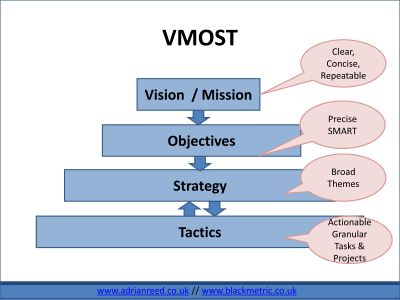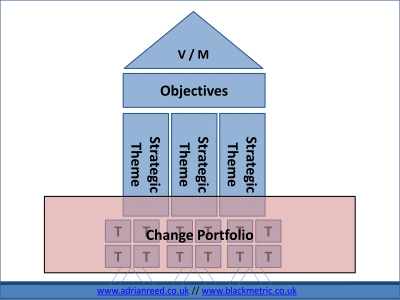Say the word ‘strategy’, and many people will respond with a glazed look and a sigh. Seen as a Dilbert-esque ‘corporate’ buzzword, people throughout organisations often disengage, seeing strategic thinking as something for those in a ‘corner office’ or an ivory tower. It is often seen as disconnected from the real-world, with bland internally-focussed vision statements and strategic plans festering away twenty-six links deep on a corporate intranet.

Adrian Reed, Principal Consultant, Blackmetric Business Solutions, Click here to contact Adrian
Adrian will be presenting the following session: Systems Thinking: A Crucial BA Skill in an Uncertain World at the Business Analysis Conference Europe 2017, 25-27 September, London
Previously published here http://www.adrianreed.co.uk
Yet as business analysts, we know that pursuing change and innovation without a cohesive set of strategic principles is like setting sail without a planned destination, a compass or a map. All important change requires co-ordinated effort, and this cohesion can be achieved with a clear, crisp, concise strategy. Done well, this ensures we have a laser-like focus on delivering products and services in a way that our customers love. Yet a question that we might often ask is what actually is “strategy”, and what is our role (as BAs) in relation to strategy?
Strategy: A Definition
There are many useful definitions of strategy out there (For example, Michael Porter has written some very useful material on competitive strategy). Yet, the definition I come back to time and time again is from a 2011 book ‘Good Strategy Bad Strategy…*’. By Richard Rumelt. In this book, Rumelt describes strategy as:
“A cohesive response to an important challenge”
Now as BAs, we could have a good debate over whether challenge is the right word. Yet, a crucial part of this definition is the idea of cohesion—of the organisation acting as one to pursue a higher mission and set of objectives. Rumelt goes on to say:
“Unlike a stand-alone decision or a goal, a strategy is a coherent set of analyses, concepts, policies, arguments, and actions that respond to a high-stakes challenge.”
In this definition we see words like analyses, concepts, policies—ideas which are extremely relevant to us as BAs. If we are engaged pre-project we will be carrying out strategic analysis of the internal and external business environment. At every stage of the project lifecycle we will be working to align the project, innovation or change initiative to the organisation’s strategy—and raising alarm bells if it doesn’t align. If we are working on something that doesn’t align then either the initiative is out of line and needs re-definition… or the strategy is out of date and needs re-visiting. Both are things that we can assist with.
A Useful Strategic Model: VMOST
There are many formal models that seek to define strategy. One of the simplest, but in my opinion most useful, is ‘VMOST’. In fact, calling VMOST a ‘model’ is almost too grand. VMOST is really just an acronym, standing for Vision, Mission, Objective, Strategy, and Tactics:

The idea being that organisations ought to have a vision and/or a mission. There is a good amount of debate in the community about the difference between a vision and mission; my (personal) take on it is that a vision is an envisioned future state, and a mission is a ‘core purpose’. This is perhaps best illustrated with an example:
Example of a vision: Alzheimer’s Society: “A world without dementia”
Example of a mission: IIBA®: “To unite a community of professionals to create better business outcomes.”
A good vision/mission acts like a guiding beacon. It tells you what the organisation does, but also what it doesn’t do. It shows what the organisation is striving for, and should be something that is unique enough to excite people throughout the organisation.
This vision/mission is then supported by objectives. Taking IIBA® UK Chapter as an example (an organisation for which I have proudly been a volunteer for over six years), we align to IIBA®’s global mission, but set local objectives. We (for example) in 2016 set out to run 24 real-world events, 9 virtual events, reach 1,000 members and so on.
We set out to achieve these objectives through broad long/medium term strategies. For example, we have a strategy of collaborating (rather than competing) with like-minded organisations—enabling us to run joint events and facilitate the cross-pollentation of ideas and knowledge.
In turn, these strategies are achieved by the day-to-day projects and tactics. This is where the ‘rubber meets the road’—and, drawing the previous diagram slightly differently, we can see that our change & innovation portfolio straddles the strategy/tactics border:

Strategy & Business Analysis
So how does strategy relate to business analysis? I would argue that the two have to go hand in hand. As BAs we play a crucial part in scouring the business environment for opportunities and threats, and we sound the alarm when strategies might need to change. We work with our sponsors and programme and portfolio management colleagues to ensure that innovative projects stay aligned with organisational strategy. We also help define a ‘change strategy’ for individual projects and programmes—strategy is fractal—it exists at multiple levels of an organisation. And we are able to help ensure that the different levels connect, enabling the organisation to push forward consistently (rather than pull itself apart with internal conflict).
Whilst strategy is often perceived as the reserve of the ‘corner office’, in reality when it is defined well it can be a crucial enabler for organisational success. We should work with our stakeholders to ensure it is clearly visible. And—an exciting ponder point to conclude this article with—if we can’t align to strategy (perhaps because it is poorly defined), we have exactly the right skills to help our stakeholders define it!
References:
Rumelt, R. (2011). Good strategy bad strategy. 1st ed, Profile Books, London
Adrian Reed is a true advocate of the analysis profession. In his day job, he acts as Principal Consultant and Director at Blackmetric Business Solutions where he provides Business Analysis consultancy and training solutions to a range of clients in varying industries. Adrian is Immediate Past President of the UK chapter of the IIBA and he speaks internationally on topics relating to Business Analysis and business change. You can read Adrian’s blog at http://www.adrianreed.co.uk. Follow Adrian on Twitter @UKAdrianReed.
Copyright Adrian Reed, Blackmetric Business Solutions


